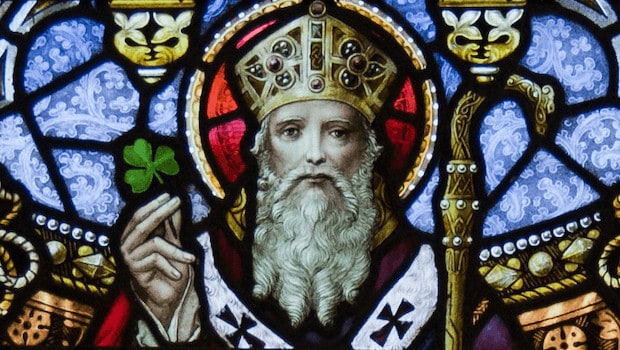March 17 is the day set aside to remember St. Patrick, but there’s more to his story than legends of driving snakes into the sea or using shamrocks to teach about the Trinity.
Here are 7 historical facts about St. Patrick and how his life impacted the spread of Christianity in Ireland.
1. Saint Patrick was not Irish.
St. Patrick (Patricius) was born in Britain, likely “on the banks of the Clyde in Scotland” in the mid-fourth century.1 His parents were also citizens of the Roman empire and, by Patrick’s confession, he was proud of his Roman heritage. His father was a decurion (part of the clergy), which implied he belonged to the class that maintained a Roman presence in Britain. They paid taxes to Rome, and in return, expected Rome’s “civil life and protection.”2 Though Patrick’s grandfather had been a priest and his father was part of the clergy, Patrick did not embrace Christianity as a child and confessed he “was ignorant of the true God.”3
2. He was once a slave in Ireland.
Though he was proud of his Roman connection and social standing, Rome did not protect Patrick. At 16, he was captured by Irish pirates, sold into slavery, and under his master Milcho, tended to sheep and pigs in the nearby hills and “lived like an animal himself, enduring long bouts of hunger, thirst, and isolation.”4In that dark time, “God opened his unbelieving eyes,” and he began to pray. One night, Patrick heard a voice saying, “You fast well, and will soon return to your native country” and again a voice told him, “Lo, your ship is ready.”5 After escaping back to Britain six years later, Patrick entered the Church and was ordained a bishop, clinging to the religion he had ignored as a youth.
3. He was not the first evangelist in Ireland.
Before the spread of Christianity reached the island, many of Ireland’s inhabitants were pagans—mostly practicing Druids. Pope Celestine consecrated a man named Palladius and sent him by ship in AD 431 as the first bishop to the Irish. But when Palladius landed in Hy-Garchon (modern-day Wicklow on the east coast of Ireland), he was not well received by the inhabitants6
who eventually banished him from their land. He left for Scotland never to return to Ireland.
4. But he did return to Ireland as a missionary.
While in captivity, Patrick had learned and fallen in love with the Irish language and culture. Deeply burdened for the people who had enslaved him, he returned to Ireland in his mid-40s. Though Palladius had failed his mission, there were some Christians upon Patrick’s arrival—and the fields were ripe for harvest. Because his former master in Ireland, Milchu, was a chieftain, Patrick was intimately familiar with the Irish clan system and their beliefs. So he focused on converting chiefs first, who would then convert their clans through their influence—and Milchu was one of his earliest converts.7 His deep respect and love for Ireland’s people and the culture he had come to embrace impacted many to believe.8 Though Patrick was not alone in converting all of Ireland, his work left an indelible mark on the country and on the people he once walked among as a slave.
5. St. Patrick’s most intense opposition came from the Druids.
Paganism was dominant in Ireland when Patrick arrived, and the people hostile. Most opposition came from the Druids—a Celtic and Gaulish religion known for contacting the spirit world, using holistic medicines to treat illnesses, and practicing magic. They were also skilled in law and history and frequently advised Irish kings. Many sought to kill Patrick, who wrote:
Daily I expect murder, fraud or captivity . . . but I fear none of these things because of the promises of heaven. I have cast myself into the hands of God Almighty who rules everywhere.9
6. St. Patrick believed God had chosen him to bring the gospel to the last place on Earth.
Patrick often used the phrase “the very ends of the earth” in his writing, taken from Luke 11:31 (see also Matt 12:42; Acts 1:8, 13:47). He believed he was “the chosen vessel to bring the gospel to the last place on earth, and so the herald of the last times, that the end was imminent and with his fellow Irish Christians, he bears witness to it to the place beyond which no one lives.”10
Patrick saw himself as a stranger in Ireland working on the fringes of human space and time. His work of evangelization belongs to the final, and most difficult, phase of a process that began with the sending out of the apostles by Christ to the whole world (Matthew), starting with Jerusalem and reaching out to every nation out to the very ends of the earth (Luke/Acts). He . . . has carried out successfully his part in this work, so his finishing his work coincides with the completion of the whole apostolic task. The completion of this task ushers in the completion, the judgment, the coming of the Son of Man in glory.11
7. His work impacted Church history.
Though not technically a saint (St. Patrick was never canonized), he is known as the “apostle of Ireland.” By his death on March 17, 461, he had planted more than 300 churches in Ireland. Thousands came into the Church under his leadership, and his work in Ireland expanded Christianity beyond the island to all of Europe.
Today, Christianity is the predominant religion in Ireland.
***
To learn more about Saint Patrick and the history or Christianity in Ireland, we recommend:
- Saint Patrick: The Man and His Works
- St. Patrick, Apostle of Ireland (2 vols.)
- Classic Studies on St. Patrick (4 vols.)
- Healy, John. The Life and Writings of St. Patrick with Appendices, Etc. (M. H. Gill & Son, LTS., New York, NY, 1905), 26.
- O’Loughlin, Thomas. St Patrick: the Man and His Works. (London: SPCK, 2014), 20.
- Healy, 36.
- Galli, M., & Olsen, T. 131 Christians Everyone Should Know, in “Introduction” (Nashville, TN: Broadman & Holman Publishers), 229–230.
- Healy, 51.
-
Todd, James Henthorn, and James Raine. St Patrick, Apostle of Ireland: a Memoir of His Life and Mission, (Dublin: Hodges, Smith, 1864), 289–290.
- https://www.christianitytoday.com/history/2008/august/real-st-patrick.html
- Mark, Joshua J. “Saint Patrick.” Ancient History Encyclopedia. Last modified September 06, 2015. https://www.ancient.eu/Saint_Patrick/. Accessed 11 March 2020.
- Galli, M., & Olsen, T., 230.
- Healy, see Confessio, 34.
- O’Loughlin, 45.





